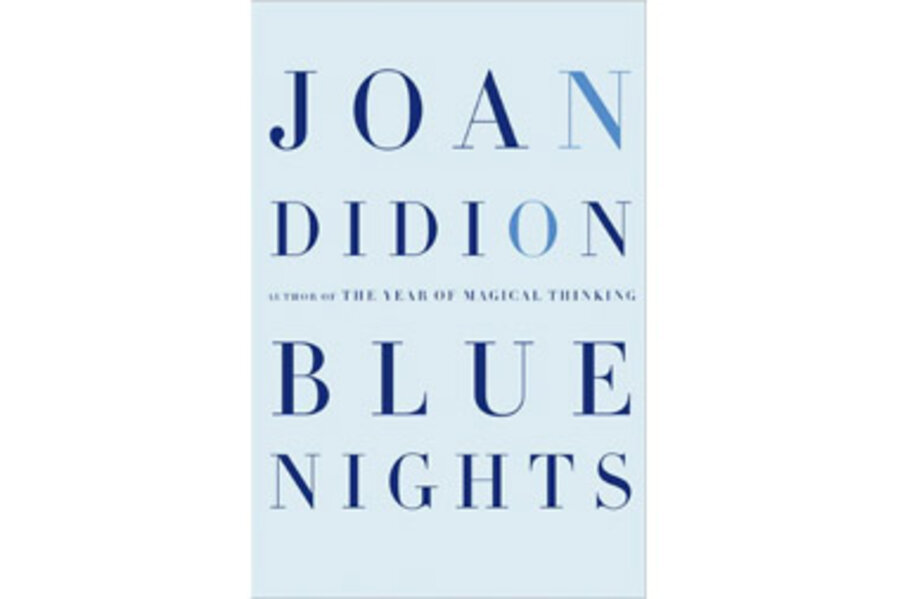Blue Nights
Loading...
There are lots of memoirs about starting over after tragedy, about overcoming grief and forging a new life. This is not one of those memoirs. Blue Nights is about loss, in all its forms.
On Dec. 30, 2003, Joan Didion and her husband, the writer John Gregory Dunne, came home from visiting their daughter in the intensive care unit, where she was in a medically induced coma. That night at dinner, Dunne died suddenly from a heart attack. Less than two years later, their daughter, Quintana, died, just after her mother’s most famous book was published.
Didion won the National Book Award for “The Year of Magical Thinking,” her unsparing, lucid examination of her grief and tangled thought processes in the months after Dunne’s death. If you’ve lost a loved one since 2005, the odds are good that someone has lovingly pressed a copy into your hands. Turning her investigative journalist’s eye inward, Didion’s ability to scrutinize her own consciousness to chronicle that raw time spoke directly to thousands of people reeling from loss.
That willingness to wield her honed talent on herself, as well as to look unflinchingly at a subject most Americans shy away from, are again on display in her elliptical, devastating new memoir, “Blue Nights.”
The book’s title comes from the French word for the gloaming. In a preface, Didion writes, “This book is called ‘Blue Nights’ because at the time I began it I found my mind turning increasingly to illness, to the end of promise, the dwindling of the days, the inevitability of the fading, the dying of the brightness. Blue nights are the opposite of the dying of the brightness, but they are also its warning.”
“Blue Nights” opens on July 26, 2010, on the anniversary of Quintana’s wedding day. Didion shares glimpses – the “peach-colored cake from Payard,” the red soles of her daughter’s Christian Louboutin shoes. Quintana herself remains elusive, seen in snatches and scraps of her mother’s memory. “Quintana is one of the areas about which I have difficulty being direct,” Didion writes.
She and Dunne adopted Quintana and brought her home from the hospital on March 3, 1966, when Didion’s career as a journalist was taking off. (She almost took the baby to Saigon, shopping for parasols and pastel dresses for them both. Happily, the trip was canceled.) When Quintana was small, the three traveled to New York, Honolulu, and Paris, staying in hotels while Dunne and Didion worked on screenplays like “The Panic in Needle Park” and profiled the band Chicago. The five-year-old learned to order triple lamb chops from room service and sign for Shirley Temples.
Didion is oddly defensive about the question of “privilege.” It may not have been a conventional upbringing, but it sounds like the trio had a lot of fun. And who’s to say “Bambi” isn’t more scarring than the “Nicholas and Alexandra” screening Didion took her daughter to?
“‘You have your wonderful memories,’ people said later, as if memories were solace,” Didion writes. “Memories are not.... Memories are what you no longer want to remember.”
Didion blames herself for many things: for not realizing the depth of Quintana’s fear of abandonment and for her own terror of not knowing what to do as a mother. “Once she was born I was never not afraid,” she writes, in what may be the book’s saddest sentence. When Quintana got her first loose tooth, her panicked mother nearly took her to the emergency room. “What I would not realize for another few years was that I had never been the only person in the house to feel the fear.”
One of the things Didion approaches obliquely is what she calls Quintana’s “depths and shallows,” which were diagnosed first as manic depression, then obsessive compulsive disorder, then something else Didion couldn’t remember. It didn’t matter, she writes, because that was soon replaced with another “diagnosis.” “I put the word ‘diagnosis’ in quotes because I have not yet seen that case in which a ‘diagnosis’ led to a ‘cure,’ or in fact to any outcome other than a confirmed, and therefore an enforced, debility,” writes Didion, who details her own bouts of ill health and inconclusive diagnoses in the book.
Frailty is a theme running throughout “Blue Nights.” In addition to Quintana, Didion writes about the death of Natasha Richardson, whom she had watched grow up. And she discusses the physical cost of “maintaining momentum” and her own growing shakiness. At one point, during rehearsals for the play of “The Year of Magical Thinking,” she can’t bring herself to get up off a metal folding chair. Didion details days spent in hospital waiting rooms, trying to figure out who to put down as her emergency contact. She works on gaining weight and momentum. “Meanwhile ... I memorize my child’s face.”
Didion once famously wrote that “We tell ourselves stories in order to live.” In “Blue Nights,” her aim is a poignant variant. She wanted to prove “that my frailty has not yet reached a point at which I can no longer tell a true story.” Not by a long shot.
Yvonne Zipp regularly reviews fiction for the Monitor.






